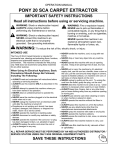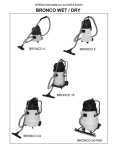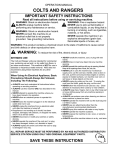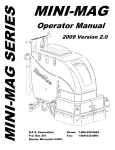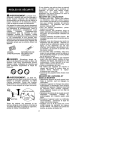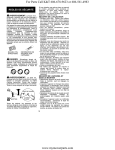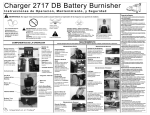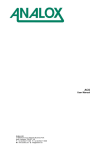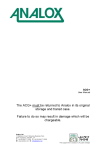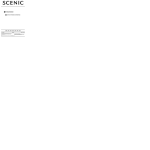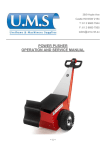Download COLT 800 PB - floor equipment parts
Transcript
OPERATION MANUAL COLT 800 PB IMPORTANT SAFETY INSTRUCTIONS WARNING: Failure to observe these instructions can cause personal injury to machine operator or bystanders. WARNING: Fire or explosion hazard. NEVER operate this machine in an explosive atmosphere (grain dust, flammable liquids or fumes, etc.). INTENDED USE The Colt 800 PB units are intended for commercial use, vacuuming up wet and / or dry spills from floors, in an indoor environment. This machine is NOT for use in asbestos or hazardous waste removal. NSS does not recommend using these machines for any other purpose. FOR SAFETY: • ALWAYS read and understand all instructions before operating or servicing machine. • ALWAYS use this machine ONLY as described in this manual. • NEVER attempt to operate this machine unless you have been trained in its operation. • NEVER allow an untrained person to operate this machine. • NEVER attempt to operate this machine if it is not working properly or has been damaged in any manner. • If appliance is not working as it should, has been dropped, damaged, left outdoors, or dropped into water, return it to a service center. • NEVER disconnect or modify any switches or safety devices. • NEVER drop or insert any object into any machine opening. • NEVER operate this machine with any air opening blocked. Keep all air openings free of dust, lint, hair, etc. • NEVER allow the vacuum motor or battery-charging plug to get wet or a short may occur. • NEVER operate this machine when the battery charger is plugged in. WARNING: Fire or explosion hazard. NEVER use to pick up flammable or combustible liquids, or any thing that is burning or smoking, such as cigarettes, matches, or hot ashes. • NEVER unplug charger by pulling on the cord. To unplug the battery charger cord from the outlet, grasp the plug, not the cord. • NEVER pick up anything that is burning or smoking, such as cigarettes, matches or hot ashes. • NEVER allow this machine to be used as a toy. Close attention is necessary when used by or near children. • ALWAYS wear clean tennis shoes or “non-slip” shoes. Leather shoes will become extremely slippery when wet. • ALWAYS keep face, fingers, hair or any other body part or loose clothing away from any machine opening or moving part. • ALWAYS use extreme caution when operating the machine on a ramp or loading / unloading this machine into or out of a truck / trailer. Use extreme caution if the ramp is wet, oily, or covered with cleaning chemicals. • NEVER stop or turn the machine on a ramp or incline. • ALWAYS use extreme care when cleaning on stairs or when machine is placed on stairs. • NEVER operate this machine with out the dust bag and / or filters in place, except during wet pick-up. • NEVER use any attachments other than the manufacturers recommended attachments. • NEVER spray this machine with water or any liquids. • NEVER operate the machine outdoors. • NEVER expose the machine to rain, snow, or extreme temperatures. • ALWAYS store this machine indoors in a dry, cool area. ALL REPAIR SERVICE MUST BE PERFORMED BY AN NSS AUTHORIZED DISTRIBUTOR / SERVICE STATION USING ONLY NSS ORIGINAL EQUIPMENT PARTS. SAVE THESE INSTRUCTIONS Colt 800 PB Operation Manual, Orig. 09-05 Rev A 10-05 7591021 MANUEL D'UTILISATION COLT 800 PB IMPORTANTES INSTRUCTIONS DE SÉCURITÉ AVERTISSEMENT: Ne pas respecter ces instructions peut mener à des blessures pour l'opérateur de l'appareil ou les spectateurs. AVERTISSEMENT : Danger d'incendie ou d'explosion. NE JAMAIS faire fonctionner cet appareil dans un milieu explosif (poussière céréalière, liquides ou fumées inflammables, etc.). UTILISATION PRÉVUE Les appareils Colt 800 PB sont des appareils à utilisation commerciale pour aspirer les déversements humides et/ou secs des planchers, dans un milieu intérieur. Cet appareil N'est PAS pour retirer l'amiante ou les déchets dangereux. NSS ne recommande pas d'utiliser ces appareils à d'autres fins. DE SÉCURITÉ : • TOUJOURS lire et comprendre toutes les instructions avant d'utiliser ou de réparer l'appareil. • TOUJOURS utiliser l'appareil SEULEMENT selon la description dans ce manuel. • NE JAMAIS essayer de faire fonctionner cet appareil à moins d'être formé pour son utilisation. • NE JAMAIS permettre à une personne non formée de faire fonctionner cet appareil. • NE JAMAIS essayer de faire fonctionner cet appareil s'il ne fonctionne pas correctement ou s'il a été endommagé de quelque manière que ce soit. • SI l’appareil ne fonctionne pas correctement, a été échappé, endommagé, laissé à l’extérieur ou échappé dans l’eau, retournez-le à un centre de service. • NE JAMAIS débrancher ou modifier les interrupteurs ou les dispositifs de sécurité. • NE JAMAIS laisser tomber ou insérer un objet dans toute ouverture de l'appareil. • NE JAMAIS faire fonctionner cet appareil lorsqu'une ouverture d'air est bloquée. Garder toutes les ouvertures d'air libres de poussières, peluche, cheveux, etc. • NEJAMAIS laisser le moteur ou la prise de charge de la batterie se mouiller ou se court-circuiter. • NE JAMAIS faire fonctionner cet appareil avec le chargeur de batterie branché. AVERTISSEMENT : Danger d'incendie ou d'explosion. NE JAMAIS utiliser pour ramasser des liquides inflammables ou combustibles ou toute autre chose qui brûle ou fume, comme des cigarettes, des allumettes ou des cendres chaudes. • NE JAMAIS débrancher le chargeur en tirant le cordon. Pour débrancher le cordon du chargeur de batterie de la prise, agripper la fiche non pas le cordon. • NE JAMAIS ramasser quelque chose qui brûle ou fume, comme des cigarettes, des allumettes ou des cendres chaudes. • NE JAMAIS laisser cet appareil servir de jouet. Attention tout particulièrement lorsque l'appareil est utilisé par ou près d'enfants. • TOUJOURS porter des souliers de tennis ou des souliers « antidérapants ». Les souliers à semelles de cuir sont extrêmement glissants lorsqu'ils sont mouillés. • TOUJOURS garder le visage, les doigts, les cheveux ou toute autre partie du corps ou vêtements amples loin de toute ouverture de l'appareil ou pièce mobile. • TOUJOURS être prudent en utilisant l'appareil sur une rampe ou en chargeant / déchargeant cet appareil dans ou hors d'un camion / d'une remorque. Être particulièrement prudent si la rampe est mouillée, huileuse ou couverte de produits chimiques de nettoyage. • NE JAMAIS s'arrêter ou tourner l'appareil sur une rampe ou une pente. • TOUJOURS utiliser l'appareil prudemment en nettoyant les escaliers ou lorsque l'appareil lui-même est sur l'escalier. • NE JAMAIS faire fonctionner cet appareil sans sac à poussières et / ou filtres en place, sauf durant le ramassage mouillé. • NE JAMAIS utiliser d'accessoires autres que ceux recommandés par le fabricant. • NE JAMAIS pulvériser cet appareil d'eau ou d'autres liquides. • NE JAMAIS faire fonctionner l'appareil à l'extérieur. • NE JAMAIS exposer l'appareil à la pluie, à la neige ou à des températures extrêmes. • TOUJOURS ranger cet appareil à l'intérieur dans un endroit sec et frais. TOUTES LES RÉPARATIONS DOIVENT ÊTRE EFFECTUÉES PAR UN DISTRIBUTEUR / STATION SERVICE AUTORISÉ(E) NSS UTILISANT SEULEMENT DES PIÈCES ORIGINALES NSS. CONSERVER CES INSTRUCTIONS IMPORTANT SAFETY INSTRUCTIONS BATTERY POWERED EQUIPMENT WITH ON BOARD CHARGERS WARNING: Failure to observe these instructions can cause personal injury to machine operator or bystanders. Read and understand all instructions before installing or charging batteries. No smoking, open flames, or sparks while working with batteries. Contains acid. Avoid contact. Poison. Causes severe burns. Avoid contact. WARNING: Batteries emit hydrogen, which can cause fire or explosion. NEVER smoke, light a match, or cause a spark during operation or charging. ALWAYS charge in a well-ventilated area away from open flame. GENERAL BATTERY CHARGING • ALWAYS read and understand all instructions before installing or charging batteries. • NEVER attempt to install or charge batteries unless you have been trained to do so. • NEVER allow an untrained person to install or charge batteries. • ALWAYS remove all jewelry when working on or near the batteries. • ALWAYS turn off all switches during installation and service. • ALWAYS disconnect the battery leads before performing any service or repair. • ALWAYS wear eye protection and protective clothing to avoid contact with battery acid. • NEVER lay anything on top of batteries as arcing may occur. • IF CONTACT WITH BATTERY ACID OCCURS, follow these instructions: • SKIN – rinse area with water. • EYES – Flush with water for 15 minutes. • INTERNAL – Drink water or milk. Follow with Milk of Magnesia, beaten egg or vegetable oil. Call a physician immediately. • ALWAYS read instructions on charger carefully. • ALWAYS use the NSS supplied charger with proper voltage rating. • ALWAYS check to ensure the battery water level covers the battery plates before charging. • ALWAYS check water level after charging and add water if necessary to bring level to the bottom of the fill hole. • NEVER overfill batteries as battery and machine damage may result. • ALWAYS wipe any acid from the top of batteries using a soap solution. • ALWAYS study battery manufacturers’ specific precautions such as recommended rates of charge. • ALWAYS reattach caps to batteries. Do not charge with caps loose or removed. • ADD only distilled or treated city water. Not well water. • NEVER charge a frozen battery. • ALWAYS plug the charger into a grounded socket outlet. • NEVER touch uninsulated portion of output connector or uninsulated battery terminal. • ALWAYS disconnect the AC supply before making or breaking the connections to the battery while charging. • NEVER open or disassemble charger. • NEVER operate charger if the AC supply cord is damaged or if the charger has received a sharp blow, been dropped, or otherwise damaged in any way. BATTERY INSTALLATION • ALWAYS use two people to install, as batteries are heavy. • ALWAYS turn off all machine switches. • ALWAYS position batteries as shown on the machine installation decal. • ALWAYS connect batteries as shown on the machine installation decal to avoid shorting out the batteries and the electrical system. ALL REPAIR SERVICE MUST BE PERFORMED BY AN NSS AUTHORIZED DISTRIBUTOR / SERVICE STATION USING ONLY NSS ORIGINAL EQUIPMENT PARTS. IMPORTANTES INSTRUCTIONS DE SÉCURITÉ ÉQUIPEMENT À BATTERIE AVEC CHARGEURS INTÉGRÉS AVERTISSEMENT : Ne pas respecter ces instructions peut mener à des blessures pour l'opérateur de l'appareil ou les spectateurs. Lire et comprendre toutes les instructions avant d'installer ou de charger les batteries. Ne pas fumer, aucune flamme nue ou étincelles en travaillant avec les batteries. Contient de l’acide. Évitez tout contact. Poison. Cause de graves brûlures. Évitez tout contact. AVERTISSEMENT: Les batteries émettent de l'hydrogène, qui pourrait provoquer un incendie ou une explosion. NE JAMAIS fumer, allumer une allumette ou provoquer une étincelle durant l'utilisation ou la charge. TOUJOURS charger dans un endroit bien ventilé loin des flammes nues. GÉNÉRALITÉS • TOUJOURS lire et comprendre toutes les instructions avant d'installer ou de charger les batteries. • NE JAMAIS essayer d'installer ou de charger les batteries à moins d'être formé pour le faire. • NE JAMAIS permettre à une personne non formée d'installer ou de charger les batteries. • TOUJOURS retirer tous les bijoux avant de travailler sur ou près des batteries. • TOUJOURS éteindre les commutateurs durant l'installation et l'entretien. • TOUJOURS débrancher les fils de la batterie avant tout entretien ou réparation. • TOUJOURS porter une protection oculaire et des vêtements protecteurs pour éviter tout contact avec l'acide de batterie. • NE JAMAIS déposer quelque chose sur le dessus des batteries car un arc pourrait en découler. • S'IL Y A CONTACT AVEC L'ACIDE DES BATTERIES, suivre ces instructions : • PEAU – rincer l'endroit à l'eau. • YEUX – rincer à grande eau pendant 15 minutes. • INTERNE – boire de l'eau ou du lait. Faire suivre de lait de magnésie, d'un oeuf fouetté ou d'huile végétale. Appeler immédiatement un médecin. INSTALLATION DE LA BATTERIE • TOUJOURS utiliser deux personnes pour installer car les batteries sont lourdes. • TOUJOURS éteindre tous les interrupteur de l'appareil. • TOUJOURS placer les batteries tel qu'indiqué sur le décalque d'installation de la machine. • TOUJOURS brancher les batteries tel qu'indiqué sur le décalque d'installation de la machine pour éviter tout court-circuit des batteries et du système électrique. CHARGE DE BATTERIE • TOUJOURS lire les instructions attentivement sur le chargeur. • TOUJOURS utiliser le chargeur fourni par NSS avec la bonne tension. • TOUJORUS vérifier pour s'assurer que le niveau d'eau de la batterie couvre les plaques de batterie avant la charge. • TOUJOURS vérifier le niveau d'eau après la charge et en ajouter au besoin pour que le niveau d'eau soit au bas du trou de remplissage. • NE JAMAIS trop remplir les batteries car cela pourrait endommager la batterie et la machine. • TOUJOURS essuyer tout acide du dessus des batteries à l'aide d'une solution savonneuse. • TOUJOURS étudier les précautions spécifiques du fabricant de batteries comme les vitesses de charge recommandées. • TOUJOURS remettre les bouchons des batteries. Ne pas charger avec des bouchons desserrés ou retirés. • AJOUTER seulement de l'eau distillée ou de ville traitée. Non pas de l'eau de puits. • NE JAMAIS charger une batterie gelée. • TOUJOURS brancher le chargeur dans une prise mise à la terre. • NE JAMAIS toucher de section non isolée du connecteur de sortie ou de la borne de batterie non isolée. • TOUJOURS couper le courant alternatif avant d'établir ou de couper les connexions de la batterie en chargeant. • NE JAMAIS ouvrir ou démonter le chargeur. • NE JAMAIS faire fonctionner le chargeur si le cordon est endommagé ou si le chargeur a reçu un coup dur, a été échappé ou endommagé de quelque autre façon. TOUTES LES RÉPARATIONS DOIVENT ÊTRE EFFECTUÉES PAR UN DISTRIBUTEUR / STATION SERVICE AUTORISÉ(E) NSS UTILISANT SEULEMENT DES PIÈCES ORIGINALES NSS. IMPORTANT SAFETY INSTRUCTIONS GROUNDING OF ELECTRICAL EQUIPMENT WARNING: Improper connection of the equipment–grounding conductor can result in a risk of electric shock. Check with a qualified electrician or service person if you are in doubt as to whether the outlet is properly grounded. Do not modify the plug provided with the machine – if it will not fit the outlet; have a proper outlet installed by a qualified electrician. Always use a properly grounded 3-wire extension cord, which has male and female plugs. If 25 foot extension cords are used, the cord size and construction should be no less than 14-3 ST., 50-foot extension cords no less than 12-3 ST. GROUNDING INSTRUCTIONS This charger shall be grounded while in use to protect the operator from electric shock. The machine is provided with a three-conductor cord and a three-contact grounding type attachment plug. The plug must be plugged into an appropriate outlet that is properly installed and grounded in accordance with all local codes and ordinances. The green conductor in the cord is the ground wire. Never connect this wire to other than the grounding pin of the attachment plug. Check nameplate on the machine to be sure voltage and cycle stated is the same as the electrical outlet. Do not attempt to plug a 120-volt machine into a 240-volt outlet or a 240-volt machine into a 120-volt outlet. If the machine is provided with an attachment plug as shown in Figure A. below, it is intended for use on a nominal 120-volt circuit. If a properly grounded receptacle as shown in Figure A. is not available, an adapter may be installed as shown in Figure B. if the outlet box that houses the receptacle is grounded. Be sure to fasten the grounding tab (the green colored rigid ear, lug or the like extending from the adapter) with a metal faceplate screw. If the machine is provided with an attachment plug as shown in Figure C., it is intended for use on a nominal 240-volt circuit. No adapter is available for this plug. NOTE: In Canada, the use of a temporary adaptor is not permitted by Canadian electrical code. ALL REPAIR SERVICE MUST BE PERFORMED BY AN NSS AUTHORIZED DISTRIBUTOR / SERVICE STATION USING ONLY NSS ORIGINAL EQUIPMENT PARTS. SAVE THESE INSTRUCTIONS IMPORTANTES INSTRUCTIONS DE SÉCURITÉ MISE À LA TERRE DE L'ÉQUIPEMENT ÉLECTRIQUE AVERTISSEMENT : Toute mauvaise connexion de l'appareilconducteur de mise à la terre peut mener à un risque de choc électrique. Vérifier auprès d'un électricien ou d'un réparateur qualifié si vous avez des doutes quant à la mise à la terre appropriée de la prise. Ne pas modifier la fiche fournie avec l'appareil – si elle n'entre pas dans la prise, faire installer une prise appropriée par un électricien qualifié. Toujours utiliser une rallonge à 3 fils mise à la terre et à prises mâle et femelle. Si vous utilisez une rallonge de 25 pieds, la taille du cordon et sa construction ne doit pas être inférieure à 14-3 ST., les rallonges de 50 pieds d'au moins 12-3 ST. INSTRUCTIONS DE MISE À LA TERRE Cet appareil chargeur doit être mis à la terre lorsqu'il est en marche pour protéger l'opérateur de tout choc électrique. L'appareil est fourni avec un cordon à 3 conducteurs et une fiche de branchement masse à trois contacts. La fiche doit être branchée dans une prise appropriée, installée et mise à la terre correctement selon tous les codes et ordonnances locaux. Le conducteur vert du cordon est le fil de masse. Ne jamais brancher ce fil à autre chose que la broche de masse de la fiche de branchement. Vérifier la plaque signalétique de l'appareil pour être certain que la tension et le cycle indiqués sont les mêmes que la prise électrique. Ne pas essayer de brancher un appareil de 120 volts à une prise de 240 volts ou un appareil de 240 volts à une prise de 120 volts. Si l'appareil est fourni avec une fiche de branchement tel qu'indiqué dans la figure A. plus bas, il doit donc être utilisé avec un circuit nominal de 120 volts. S'il n'y a pas de prise mise à la terre telle qu'indiqué dans la figure A. disponible, on peut installer un adaptateur tel qu'indiqué dans la figure B. si la boîte à prises est mise à la terre. S'assurer d'attacher la patte de mise à la terre (boucle, cosse rigide de couleur verte ou quelque chose de semblable sortant de l'adaptateur) avec une vis de plaque signalétique de métal. Si l'appareil est fourni avec une fiche de branchement tel qu'indiqué dans la figure C., il doit donc être utilisé avec un circuit nominal de 240 volts. Il n'y a aucun adaptateur disponible pour cette fiche. REMARQUE : Au Canada, l'utilisation d'un adaptateur temporaire est interdite par le code d'électricité canadien. TOUTES LES RÉPARATIONS DOIVENT ÊTRE EFFECTUÉES PAR UN DISTRIBUTEUR / STATION SERVICE AUTORISÉ(E) NSS UTILISANT SEULEMENT DES PIÈCES ORIGINALES NSS. CONSERVER CES INSTRUCTIONS Attaching Various Hoses Hose cuffs may be difficult to attach when new. To ease installation you may have to hold the hose cuff under HOT tap water for 2 to 3 minutes to soften the hose cuff. NOISE AND VIBRATION NOISE – COLT 800 PB Sound pressure level at Operator position (wet Pick-up) 62 dB(A) Squeegee Hose (if applicable) • The end of the hose with the larger diameter cuff is attached to the hose coupling by sliding it on. The opposite end with the cuff that is smaller in diameter is attached to the squeegee. MACHINE INSPECTION • Now that the machine is unpacked remember to recycle all packing materials. • Inspect the machine for damage or missing components. If damage is found, contact the local freight company to file a freight claim. Super Flex hose with Swivel cuff for use with a wand • The end of the hose with the larger diameter cuff is attached to the hose coupling by sliding it on. The opposite end with the cuff that is smaller in diameter and movable is attached to the wand. PREPARING THE MACHINE Installing the batteries: • Read all safety instructions in this manual before installing batteries. • Turn off switch. • Unplug power head cord and remove power head. • Empty the tank of all dirt or liquid. • Unlock the tank latches at the front of the machine and tilt back 8-gallon can. • Refer to the wiring diagram on the bottom of the 8gallon can. • Align the batteries in the compartment as shown on the diagram. • Install the battery cables as shown on the wiring diagram. • Tighten hex nuts with a wrench. Install the Squeegee Assembly (if applicable): • Place the squeegee lift arm in the storage (up) position. • The squeegee assembly mounts to the squeegee lift arm using two (2) mounting knobs. Loosen the mounting knobs and slide the squeegee assembly onto the mounting plate. • The squeegee assembly has two (2) small wheels to prevent “rollover”. The roller wheels must be forward of the squeegee assembly. Hand tighten the mounting knobs. Do not use pliers to tighten. • Do not add any weights or other pressure to the squeegee mechanism. This will not improve the performance and will shorten the life of the blades. Caution: Do not short across two terminals with a OPERATING THE MACHINE wrench. To turn the machine on, flip the switch located on the upper left corner of the rear of the machine base. • When using the wand with the squeegee tool on floors, the operator should drop his / her arm slightly to allow air to enter the front edge of the tool on the forward stroke. On the backward stroke the operator should raise his / her arm slightly to allow the back edge of the tool to clear the floor. This method gives the air a chance to do the work in the most effective manner. • The operator should make strokes at a leisurely pace and at a length that feels the most natural. • Always work away from the machine, pulling the machine behind you. • Loose or improper battery connections will cause battery or machine damage and possible personal injury. Battery Charging • To recharge the batteries plug the charger cord, located at the rear of the machine, into an electrical outlet. • When the cord is plugged into an outlet the machine will become disabled. See charging instructions for more details. Installing the hose coupling • Push in on the plunger pin, on the left side of the intake, then, insert the larger diameter end of the hose coupling into the intake opening until it stops. Release the plunger pin. • To remove; push in on the plunger pin, grasp the coupling and pull. Dry Pick Up • Clean or replace the filter bag when suction is reduced. • Choose the proper wand and tool • Use a paper bag to make disposal easier. Wet Pick Up The Micro Filter Assembly, HEPA Assembly, or Filter Bag may be used when picking up liquids. The Filter Bag helps prevent debris and foam from being pulled into the vacuum motor and fans, causing motor damage and possible failure. • The motor will speed up and sound different when the airflow is closed off. 7 • As the liquid level rises the built-in float will be activated, when the liquid reaches the bottom of the float the float will close off the airflow only, not the vacuum motor. • The built in float will not be activated by foam. • NSS recommends that you always use a defoamer agent along with low foaming chemicals diluted according to manufacturers specifications. If the vacuum motor is flooded with liquids or foam immediately turn the motor OFF. Battery Electrolyte (Liquid) Level • Inspect the electrolyte level of at least one cell in each battery before charging. The liquid must be visible above the internal plates. Do not charge the batteries if the liquid is below the plates. • Add only water to the cell of a battery to adjust the liquid level. Distilled water preferred, Do Not use well water. Before charging, add only enough water to cover the top of the internal plates. After charging, add only enough water to bring the level to the bottom of the fill tube. • Do not overfill the battery liquid level, this will cause electrolyte (acid) spill. Spilled electrolyte (acid) can cause machine damage and personal injury. Clean up and dispose of all spills immediately. • See the battery-warning sheet for more details. HEPA Units - Dry Pick Up The HEPA and the Micro Filter Assemblies must be used to maintain HEPA level filtration. • Clean or replace the Micro Filter discs (3), and the filter bag when suction is reduced. • Replace the HEPA Filter (complete box) when suction is reduced. • DO NOT modify the filter assemblies in any manner. • Return the motor to an authorized NSS service center for inspection. Squeegee Assembly • Remove squeegee assembly from machine. • Rinse with clean water to prevent chemical residue build-up. • Allow to air dry, it can be stored on top of the machine for drying. • Inspect the squeegee assembly and vacuum hose for wear, damage, or obstruction. Repair or replace as needed. • Remove debris from squeegee hose. HEPA units are not approved for hazardous materials. MACHINE MAINTENANCE Routine maintenance is critical to ensure proper machine operation and cleaning performance. Perform all maintenance procedures as follows: Adjusting the squeegee assembly As the machine is used, the squeegee blades will wear or need to be replaced due to damage. Some adjustment may be needed. • Squeegee blades should lie over slightly (like a window squeegee) when the machine is moving in forward or reverse. WARNING: Always disconnect the battery leads before performing any maintenance. Daily Maintenance • Inspect the battery charger cord and plug for any damage. Weekly Maintenance • Verify that all daily maintenance has been performed. • Inspect all battery liquid levels. Adjust to proper level as needed. Add only water. • Check all battery terminal and cable connections. Tighten as needed. Loose connections are dangerous and can cause personal injury and machine damage. • Clean any corrosion from battery terminals and cables. • Drain all liquids from battery tray. Dispose of according to local government regulations. • Flush clean tank and hoses with a mixture of 8 oz. (250ml.) white vinegar to one-gallon (4 liter) warm water. • Repair or replace any worn or damaged components as needed. • Clean the float and float stem to remove residue buildup, and insure proper float operation. • Check all gaskets for damage and to ensure an airtight fit. Repair and / or replace as necessary. • Vacuum the filter bag to remove imbedded dirt and maintain airflow. • Oil casters and wheels with a small amount of light oil. • Apply a small amount of oil to the intake coupling and pin. NOTE: To prevent damage to the battery charger power cord, ALWAYS store the machine with the battery charger power cord coiled and tucked into its storage compartment in the machine. • Remove the hose from the machine at the end of each workday, check for obstructions and / or damage. Repair or replace as necessary. • The wand should be removed from the hose and the hose should be laid in a loose coil or hung over several pegs on the wall. • Clean the floor tool and wand of dirt and / or liquid residue. • Empty the tank after each use. • Shake the dirt and or debris from the Filter bag; if the tank and / or filter bag is wet allow to air dry. The filter bag must be cleaned after each use to prevent loss of vacuum suction and possible machine damage. Battery Charging • The power switch must be turned OFF. • Recharge the batteries at the end of every shift. • Consult your local authorized NSS distributor or service center for assistance. 8 For machine with HEPA filters: • Vacuum the micro filter discs to remove imbedded dirt and maintain airflow. • Replace prefilters when soiled. • Replace HEPA filter when loss of suction develops. BATTERY CHARGER OPERATING INSTRUCTIONS GENERAL INFORMATION AND WARNINGS • Electronic automatic battery charger with microprocessor suitable for lead acid batteries. • Fully automatic charging cycle with electronic setting; protected against overload, short-circuit at clamps and reversed polarity. • Before starting to charge, make sure the voltage of the equipment suits the voltage of the battery, that the charging current suits the capacity of the battery and that the selected charging curve (for lead-acid batteries or airtight gel batteries) is correct for the type of battery to be charged. In addition, make sure the rated input voltage of the charger suits the available supply voltage and the system is equipped with grounding. • Pay attention to any remarks of the battery manufacturer. Monthly Maintenance • Verify that all daily and weekly maintenance has been performed. • Clean polyethylene body components to remove chemical and liquid residue and maintain a “like new” appearance. CONTROLS (see figure below) 1. Three-digit display + symbol (1), to view A = the charging current, U = the battery voltage, h = the charging time, C = the charging ampere-hours [Ah], E = the energy used [KWh]. 2. Button for the Selection of the display mode (2):A, U, h, C, E. After about 10 seconds the display returns to the visualization of the charging current. 3. Red control indicator (3): when it is on, the charging cycle has started. 4. Yellow control indicator (4): when it is on, the final phase of the charging cycle has started. 5. Green control indicator (5): when it is on, the charging cycle has finished. OPERATION • Plug the cord into a socket. • Now, the battery charger’s display will show a sequence of details on the charger’s internal programming: after the name “SPE”, it will show the software release installed in the equipment, then, in sequence, the following parameters: battery voltage, charging current, charging curve number and, finally, the words “GEL” or “Acd” depending on the set up charging curve being suitable for airtight gel batteries or lead-acid batteries. Now, a test is run on the battery voltage to decide if the charging process should be started or not. If the battery is not connected to the battery charger, the display will show the word “bat”. The word will stay on, even if the test is failed (for instance, reversed polarities or incorrect battery connection). If the test is passed, the display will show the battery voltage for approximately 5 seconds and the battery will begin to be charged. The charging cycle progress will be shown by red (3), yellow (4) and green (5) LED indicators. At the end of the charge, when the green indicator (5) is on, unplug the cord from the socket and operate the machine. SMART BATTERY CHARGER 3 4 5 A = Amps U = Volts h = hours C = Ah E = KWh 1 S 2 MOD. CBHF1-SM 24V 12A 9 CBHF1-SM DIP SWITCH CONFIGURATION Through the set of 8 dipswitches it is possible to change the charging curve (15 charging curves are available for Wet and Gel batteries and it is possible to customize the charging profile under the specifications of battery manufacturers), the battery voltage (12V or 24V) and the charging current (4A or 8A or 10A or 12A). The set of 8 dip switch is easy to find (is located under the front label of the charger, lifting the corner on the bottom-left) without opening the charger. ON DIP1 DIP2 DIP3 DIP4 for the selection of the CHARGING CURVE DIP1 ON DIP2 ON DIP3 ON DIP4 ON OFF ON ON ON ON OFF ON ON OFF OFF ON ON ON OFF ON ON OFF OFF ON ON ON OFF OFF ON OFF ON OFF ON OFF ON ON OFF OFF ON ON ON ON OFF OFF OFF OFF OFF ON OFF ON OFF ON OFF ON ON OFF OFF OFF OFF OFF OFF OFF OFF OFF OFF CHARGING CURVE 0 - Curve for charging DRYFIT TRACTION BLOCK (traction gel batteries). 1 - Curve for charging TRACTION Lead-Acid (wet) batteries. SETTING FOR NSS 2392111 - BATTERY, WET 12V, 115 AMP/HR 2 - Curve for charging SEALED LEAD-ACID batteries. 3 - Curve for charging Sealed Lead-acid and GEL batteries from Trojan and other manufacturers. 4 - Curve for charging TRACTION Lead-Acid (wet) batteries w/float charge. 5 - Curve for charging SEALED LEAD-ACID batteries w/float charge. 6 - Curve for charging Sealed Lead-acid batteries and GEL batteries from Trojan and other manufacturers w/float charge. 7 - Curve for charging large capacity DRYFIT PzV (A800) GEL batteries. 8 - Curve for charging GNB Sealed Lead-Acid batteries. 9 - Curve for charging Lead-Acid start-up batteries. 10 - Curve for charging DRYSAFE HAGEN batteries. 11 - Curve for charging dryfit traction block batteries from Sonnenschein, DEKA and other manufacturers. 12 - Curve for charging Lead-Acid starting batteries with stop. 13 - Curve for charging Lead-Acid starting batteries with stop. 14 15 DIP5 DIP6 DIP7 for the selection of the CURRENT DIP5 ON OFF ON OFF DIP6 ON ON OFF OFF DIP7 ON ON ON ON DIP8 for the selection of the battery voltage CURRENT 4A 8A 10A 12A PROBLEMS The battery charger does not switch on The charging cycle does not start and the message ‘bat’ is displayed. The yellow indicator (4) will not light up even 15 hours from the starting of the charging cycle, and the display shows E03. The message E01 is displayed If the battery charger is provided with a safety thermostat and the message E02 is displayed. The message SCt is displayed The message Srt is displayed DIP8 ON OFF VOLTS 12 24 SOLUTIONS AND CHECKS Check that the plug is connected to the supply mains and that the circuit breaker is efficient. Check the connection to the battery and the polarity. Check the battery for possible faulty components. This means that the maximum voltage admissible by the battery has been exceeded. The charging is interrupted. This means that the maximum temperature has been exceeded. The charging is interrupted. This means that the total safety timer has interrupted the charging. This signals a possible internal short circuit. 10 TROUBLESHOOTING Symptom Machine does not run. Cause Batteries not charged. Solution Charge batteries. Circuit breaker tripped. Reset circuit breaker. Unplugged power head cord. Plug in power head cord. Battery cables loose or not connected. Check and connect or tighten. Damaged switch. Replace switch. Damaged power head cord. Replace power head cord. Carbon brushes worn out. Replace brushes. Vacuum motor worn out. Battery charger plugged in. Repair / replace vac motor. Unplug charger cord from wall outlet. Obstruction in hose, tool, wand or intake. Remove obstruction. Tank is full. Empty tank. Dirty filters. Improper coupling connection / air leak. Gasket missing or damaged. Clean or replace filters. Check gaskets for fit or damage. Adjust coupling connection. Replace gasket. Holes in hose. Replace hose. Machine is difficult to move. Damaged wheels. Replace wheels. Batteries do not seem to run long enough. Damaged caster. Over charging batteries. (Charging too frequently.) Tops of batteries are dirty / wet. Replace caster. Monitor run time, and adjust charging frequency accordingly. Clean / dry, charge batteries. Machine has poor or no suction. Battery terminals are dirty / damaged, or loose. Electrolyte level is too low. Batteries are not fully charged. Clean terminals, and connectors, replace damaged cables. Charge. Add distilled water and charge. Charge batteries for a full cycle on the battery charger. Charger is damaged. Have an authorized serviceman repair. Battery is defective or worn out. Check cell voltage while discharging. Repair service for this machine must be performed by an NSS authorized service center. Repairs performed by an unauthorized company will void the machine warranty. If you require assistance finding an authorized service center, contact NSS Enterprises. 11 NSS® Enterprises, Inc. 3115 Frenchmens Road, Toledo, Ohio 43607 PHONE (419) 531-2121 FAX (419) 531-3761 NSS ® Enterprises, Inc. European Distribution Centre Unit II, Pinfold Trading Estate * 55 Nottingham Road STAPLEFORD, NOTTINGHAM NG9 8AD ENGLAND U.K. PHONE: (44) 0115 939 1568 * FAX: (44) 0115 949 0615 12












